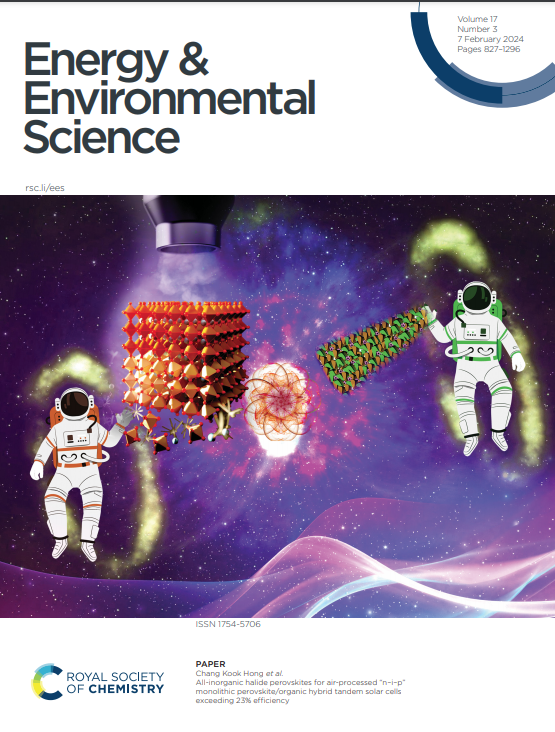High-entropy-induced CoO6 octahedral distortion for boosted oxygen evolution reaction at high temperature
IF 30.8
1区 材料科学
Q1 CHEMISTRY, MULTIDISCIPLINARY
引用次数: 0
Abstract
Modulating the distortion of BO6 octahedral plays a pivotal role in determining the physiochemical properties and electrocatalytic performance of the perovskite oxide (ABO3-δ). By tailoring the degree of octahedral tilting and bond angles, it could finely tune the electronic structure, oxygen vacancy formation, and ionic transport pathways within the perovskite lattice. Herein, we propose an efficient strategy to tune the BO6 (CoO6) octahedral distortion by the A-site high-entropy engineering in the Nd0.2Pr0.2La0.2Ba0.2Sr0.2CoO3-δ anode with the average Co-O-Co angle decreasing from 175° to 149°. Exsitu and in situ characterizations and density functional theory calculations reveal that the high-entropy-induced CoO6 octahedral distortion could shift the O 2p band center of the perovskite anode towards the Fermi level, and consequently activate the lattice oxygen and accelerate the transport of oxygen ions. Electrochemically, the CoO6-distorted Nd0.2Pr0.2La0.2Ba0.2Sr0.2CoO3-δ anode exhibits promoted high-temperature oxygen evolution reaction (OER) performance in solid oxide electrolysis cells (SOECs), with a high current density of 3.96 A·cm-2 at 1.5 V at 800 °C and stability for up to 600 hours, which is superior to most reported anode materials. This work discloses the impact of CoO6 octahedral distortion on high-temperature OER performance at atomic scale, and proposes an effective strategy for designing efficient and durable anodes of SOECs.高温促进析氧反应的高熵诱导CoO6八面体畸变
调节BO6八面体的畸变对钙钛矿氧化物(ABO3-δ)的理化性质和电催化性能起着关键作用。通过调整八面体倾斜程度和键角,它可以精细地调整钙钛矿晶格内的电子结构、氧空位形成和离子传输途径。在此,我们提出了一种有效的策略,通过a位高熵工程在Nd0.2Pr0.2La0.2Ba0.2Sr0.2CoO3-δ阳极上调节BO6 (CoO6)八面体畸变,使Co-O-Co平均角从175°降低到149°。原位表征和密度泛函理论计算表明,高熵诱导的CoO6八面体畸变可以使钙钛矿阳极的o2p带中心向费米能级移动,从而激活晶格氧并加速氧离子的输运。电化学性能方面,coo6变形Nd0.2Pr0.2La0.2Ba0.2Sr0.2CoO3-δ阳极在固体氧化物电解电池(SOECs)中表现出优异的高温析氧性能,在800℃、1.5 V下具有3.96 a·cm-2的高电流密度和长达600小时的稳定性,优于大多数报道的阳极材料。本工作揭示了CoO6八面体畸变对原子尺度高温OER性能的影响,并提出了设计高效耐用soec阳极的有效策略。
本文章由计算机程序翻译,如有差异,请以英文原文为准。
求助全文
约1分钟内获得全文
求助全文
来源期刊

Energy & Environmental Science
化学-工程:化工
CiteScore
50.50
自引率
2.20%
发文量
349
审稿时长
2.2 months
期刊介绍:
Energy & Environmental Science, a peer-reviewed scientific journal, publishes original research and review articles covering interdisciplinary topics in the (bio)chemical and (bio)physical sciences, as well as chemical engineering disciplines. Published monthly by the Royal Society of Chemistry (RSC), a not-for-profit publisher, Energy & Environmental Science is recognized as a leading journal. It boasts an impressive impact factor of 8.500 as of 2009, ranking 8th among 140 journals in the category "Chemistry, Multidisciplinary," second among 71 journals in "Energy & Fuels," second among 128 journals in "Engineering, Chemical," and first among 181 scientific journals in "Environmental Sciences."
Energy & Environmental Science publishes various types of articles, including Research Papers (original scientific work), Review Articles, Perspectives, and Minireviews (feature review-type articles of broad interest), Communications (original scientific work of an urgent nature), Opinions (personal, often speculative viewpoints or hypotheses on current topics), and Analysis Articles (in-depth examination of energy-related issues).
 求助内容:
求助内容: 应助结果提醒方式:
应助结果提醒方式:


